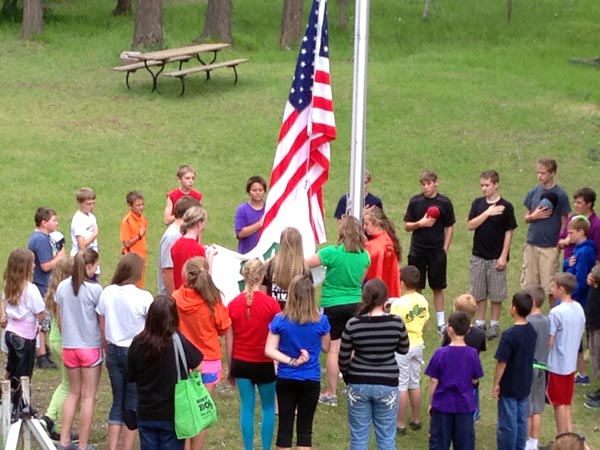Back to the Club.
Last week I had a blast chaperoning my son Cade’s first year at 4-H summer camp. The setting was beautiful: a dedicated 4-H camp set in the woods of northwestern Montana, A big gathering lodge surrounded by small 8-person cabins, right next to a calm mountain lake studded with flowering water lilies.
I went to this very camp in seventh grade, exactly 30 years ago. To return three decades later was a bit surreal, and truly delightful to discover that the camp hadn’t changed a bit. Sure, there was a new private residence or two across the far side of the lake, but otherwise, it was exactly as it looked in my memories from so long ago. I’m so glad my son had a great time, but it was also a very nice homecoming for me, back to a good time in my childhood.
But a larger homecoming for me is the return to 4-H. In the late 70s and early 80s when I first joined, there were many 4-H clubs to choose from in my community, and county fairs were always well-attended and chock full of projects and displays from earnest young 4-H’ers. It seemed to me, though, that today there are a lot less projects in the local fair, and you rarely see a 4-H headline in the newspaper. I assumed that 4-H was a relic from the past, barely clinging to existence by a few hard-core members who will inherit their family farm someday.
Boy, was I wrong.
4-H may fly a little lower under the radar these days, but it has transformed into a well-organized, efficiently-run community full of vibrant young boys and girls, enrolling in projects that I wish they offered when I was a kid
This is Cade’s first year in a 4-H club, and he enrolled in leathercraft as a good ol’ the classic starter project. But he also participated in two new projects that weren’t previously around, archery and shooting sports. These days, kids can try out Robotics, Entomology, Latino Cultural Arts, even Entrepreneurship!
4-H is strong, and it’s adapted to changing times and technology. But at its core, it’s still all the great things that make it such a fantastic organization for kids to participate in. 4-H teaches kids confidence and public speaking in front of an audience, self-determination, budgeting, community service, I could go on…
And 4-H’ers and their families are just good people. I had forgotten the unsolicited support and encouragement proffered by kids and parents alike, the camaraderie and inclusiveness one feels in a 4-H club. My son is already feeling it, especially when an older club member listens to him, and spurs him on to go boldly forth with confidence.\
During the last night of 4-H camp, we watched a slide show of all the kids and events they enjoyed throughout the week. For every slide that popped up, the kids would erupt into cheers and laughter. And even when the youngest, the shyest, the most socially-awkward kids were on the screen, the campers cheered for them enthusiastically. I don’t think those kids yet understand how powerful and meaningful that can be to a kid who might not get such encouragement at home or in school. Everyone was equal, loved, and included.
I’ll always remember that night, and those cheers of support. Coming back to 4-H after 30 years truly is a warm homecoming, amongst good people, and I’m thrilled that my kids will get to benefit from the all the great qualities of being a 4-H’er.
Here is a fantastic documentary that Montana PBS put together last year, chronicling several different families in 4-H, all across the state:
http://watch.montanapbs.org/video/2260061763/




It occurred to me as I read and thoroughly your enjoyed your account of the 4H camp, if they offer Latin American culture as a 4 H option, why not some well- crafted Indian option? It is certainly more significant to Montana and the possibilities are endless as are the resources! Perhaps there would be some money available from OPI and the Museums. There are many fine Indian educators like Julie Cajune-Salish, Leo Bird-Blackfeet, Richard Littlebear No. Cheyenne, Joe McGeshick Assiniboine, Shane Doyle-Crow and so very many more, who could help create a curriculum to obtain an option. Poetry, Native crafts in baskets, beading, leatherwork, plant lore, astronomy, horses, history, the list could be nearly endless. Luke, I know you are not a spokesperson for 4H but surely the time has come. Reservations are prime country for 4H. Don’t know what I could do but am willing to do it. Love, Aunt
Boy, I couldn’t agree more! Perhaps there already is such a program that I’m simply not aware of, but I know just who to ask. The new statewide 4-H Youth Development coordinator was also a chaperone at camp, so I’ll run this by her, and see what she thinks. Truly, in Montana especially, 4-H’ers and citizens alike could benefit from an Indian culture program. I’ll let you know what I find out!